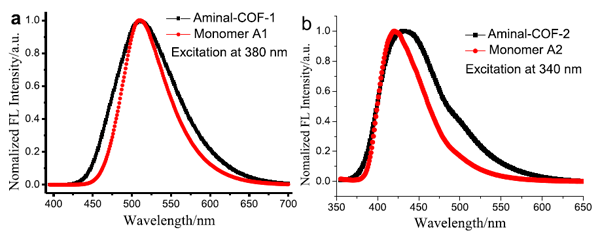[ Instrument Network Instrument Development ] Covalent Organic Frameworks (COFs) are a class of crystalline organic porous polymers formed by covalent bonding of organic elements. They have high specific surface area, low density and accurate structure. It has a wide range of applications in substance adsorption, storage and separation, heterogeneous catalysis, sensing, and optoelectronics. Since the first COF was reported in 2005, the field has grown rapidly, focusing on the development of new structures and applications. After more than 10 years of development, a variety of connection methods have been used for the construction of COFs. COFs based on different connection methods have their unique properties, which greatly increase the structural diversity of COFs, and various functions and applications have also been Developed, it has greatly promoted the development of this research field. However, developing new connections is still a big challenge.

Zhao Xin, a key laboratory for organic functional molecular synthesis and assembly chemistry, Shanghai Institute of Organic Chemistry, Chinese Academy of Sciences, has been working on organic porous materials. Recently, they have developed a new way to construct COFs: aminal linkages to construct COFs. The resulting COFs have good thermal stability, exhibit good chemical stability under alkaline and neutral conditions, and have a new topology - cpi grid. In addition, the unique structure of the aminal structure makes the interlayer interaction of the synthesized two-dimensional COFs weak and the conjugate does not extend, so the photophysical properties of the monomer are well preserved (J. Am. Chem. Soc. 2019, 141, 14981).
Imino-based linkages are widely used in the construction of COFs. Although the reaction to form aminal is similar to the Schiff base reaction of imine formation, it has good reversibility, but it has not been used in the synthesis of COFs. During the formation of aminal, due to the conversion of sp2 hybridized planar carbonyl carbon to sp3 hybridized tetrahedral aminal carbon, the large change in its configuration reduces the structural controllability of the polymer and improves the synthesis of COFs. Difficulty. In addition, the monomer not only needs to adapt to the stereo configuration change before and after the reaction, but also ensures that the reaction does not remain in the imine phase. They synthesized two non-planar D2h symmetry tetraaldehyde monomers (A1 and A2) whose non-planar structure was able to accommodate the stereostructure changes before and after the formation of aminal. Second, they use piperazine as the amine monomer, and its secondary amine structure prevents the reaction from staying in the imine phase. Through their polycondensation, they successfully obtained the first COFs (Aminal-COF-1 and Aminal-COF-2) linked by aminal. Due to the symmetry of the monomer and the particularity of the connection mode, the two COFs are alternately periodically distributed in a two-dimensional plane by a pentagonal hole and a hexagonal hole to form a cpi grid structure, which is a brand new in COFs. Topology (Figure 1).
In the two aminal-linked COFs, the piperazine unit adopts a chair conformation, and the aminal carbon exhibits a tetrahedral structure. These characteristics result in a large inter-layer spacing of the aminal COFs, and a benzene ring between the layers. The distance is greater than 6.0A, which exceeds the typical aromatic stacking distance (3.3-5.0 A), which greatly weakens the interlayer interaction. On the other hand, the aminal is a saturated structure, so that the conjugate is not expanded in a two-dimensional plane after the formation of COFs. This non-conjugated, non-planar special structure makes the interaction between the monomer elements small after COFs formation, which is beneficial to retain the properties of the monomer. They observed that the emission wavelength of COFs is almost the same as the emission wavelength of the corresponding monomer by solid fluorescence test, indicating that the aminal-linked COFs retain the photophysical properties of the monomer well (Fig. 2). This research provides a new idea for the development of functional materials based on COFs. Through the special connection of aminal, the properties of COFs can be more accurately predicted and regulated by the retention of monomer properties, and it is expected to achieve specific properties and Custom synthesis of functional COFs.
The first author of the paper is Jiang Shuyan and Gan Shixian, graduate students of Zhao Xin's research group. The above research work was funded by the National Science Fund for Distinguished Young Scholars, the Shanghai Municipal Science and Technology Commission and the Science and Technology Special Project of the Chinese Academy of Sciences (Class B).
Acrylic Medal
What are the advantages of the acrylic cup over the metal cup?
The medal made of acrylic material is strong, practical and beautiful, which has solved the most troubling problem for the public for a long time:the trophy medal will be dull and dull after being kept for a long time.The luster of the acrylic cup remains unchanged, and the texture of the trophy is still as new as it has been for decades.
Acrylic medal,acrylic trophy,customized acrylic award
Shenzhen Colorful Cloud Acrylic Products Co., Ltd. , https://www.nxuc.com

